It’s no secret that wind-turbine capacity, particularly for offshore turbines, continues to grow each year with 6 to 10 MW on the horizon. Even with efficiency improvements, key power generation subsystems —including generators, power-conversion electronics and transformers—are challenged to manage ever increasing heat within limited nacelle space. In addition, even if incurred power losses are as little as 3 to 5%, thermal management systems would have to dissipate 200 to 300 kW and more of heat.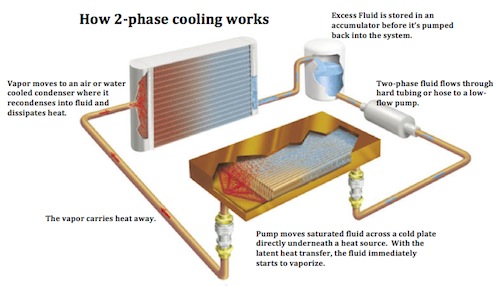
While traditional air and water-cooled systems have provided low-entry costs, water cooling is becoming more challenging to implement. Installation and maintenance costs required to safely distribute enough water to adequately cool ever larger power systems are a major concern. Rising capacity and corresponding power losses are driving thermal-solution designers to consider more advanced thermal management to minimize the overall growth of the nacelle and wind-turbine infrastructure.
Limitations to air and water
Air-cooling has served small-scale wind turbines well over the years, but it’s not practical for removing the heat produced in a megawatt-scale unit. Its thermal capacity is so low that it’s difficult to blow enough air across a motor or through the converter to maintain reliable operating temperatures. That’s why water cooling is selected more often over air for larger wind turbines.
However, water systems are relatively large, and their thermal-efficiency limitations force the size and weight of power generation sub-systems to essentially track their power throughput. That is, the power density is almost constant due to the thermal performance limitations of water, making power-generation components of a 10-MW wind turbine nearly twice the size and weight of a 5-MW model. This is largely because water cooling cannot adequately remove additional heat loads without spreading them out.
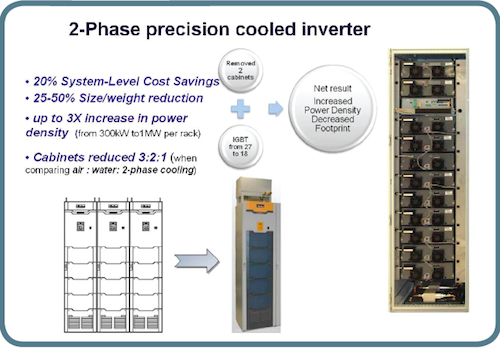
Water cooling provides some reduction in size but 2-phase cooling allows a greater additional reduction.
In addition, water’s inherent electrical-conductivity potential poses the risk of a short circuit in the event of a leak, which can be catastrophic around high-power equipment. Also, because wind turbines are often in areas where temperatures routinely drop below freezing, additives such as glycol are mixed in to lower the freezing point. However, this tends to decrease the thermal performance of the coolant. Lastly, system designers must carefully select similar metals that will contact the water. Even with a deionizer or careful monitoring of inhibitor concentrations, water is corrosive. To avoid galvanic corrosion, expensive stainless steel is often selected for all plumbing and manifolds throughout the water loop to reduce the need for long-term maintenance, especially in offshore installations where remoteness and access issues require “maintenance free” operation.
Evaporative cooling
To address the challenges of cooling high-power systems in wind turbines, a few companies have developed alternatives. One in particular, uses a noncorrosive, nonconductive coolant (refrigerant) that evaporates on contact with hot electronics, in a small, light-weight, and highly efficient closed loop.
The loop has the same basic components as a water-cooling system: pump, reservoir, cold plate or cooling coils, and condenser. The big difference however is that water doesn’t change phase as it passes over the device being cooled–it simply heats up– whereas the refrigerant liquid turns to a vapor.
By taking advantage of the more efficient evaporation, two to four times the amount of heat can be removed for the same temperature difference (°C/W) than by single-phase water cooling. This directly increases power throughput, a limitation dictated by the amount of heat that can be removed from the system at the maximum reliable operating temperature.
The two-phase evaporative approach also eliminates safety and maintenance issues associated with water cooling, while allowing greater power densities. The process’ isothermal nature also reduces thermal cycling, which increases the lifespan of the turbine’s electrical components.
Sub-systems such as generators, transformers, and power-conversion electronics can be reliably driven to support up to 40% more power for the same size or weight, simply because additional thermal loads are removed without raising the subsystem temperature.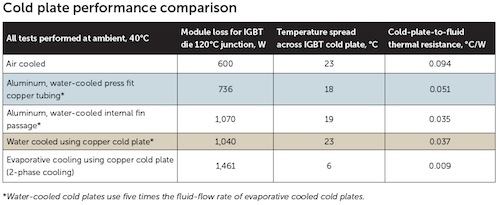 For example, a 1MW power inverter is reduced in size by a factor of 3:2 when converted from air to water cooling, and then 2:1 when converted from water to evaporative-refrigerant cooling. Given the same power throughput, fewer power modules, and supporting mechanical and electrical infrastructure are required, resulting in reductions of size and weight (up to 50%), as well as overall system cost.
For example, a 1MW power inverter is reduced in size by a factor of 3:2 when converted from air to water cooling, and then 2:1 when converted from water to evaporative-refrigerant cooling. Given the same power throughput, fewer power modules, and supporting mechanical and electrical infrastructure are required, resulting in reductions of size and weight (up to 50%), as well as overall system cost.
Size, efficiency, and benefits
The table, Cold plate performance compares a standard module cooled by air, water, and evaporative-refrigerant methods. With ambient conditions being equal and power modules limited to the same maximum surface temperature (120°C), the total measured thermal losses reached were limited to 600W for air cooling, 1,070W for the best water cooled cold plate, and 1,461W for evaporative cooling. In addition, temperature uniformity, known to impact the reliability of electronic assemblies, was much better with the evaporative-cooling system (6°C variation) than the water cooling system (19°C variation).
The evaporative system’s footprint, smaller and lighter than that of alternative thermal management equipment, coupled with its ability to reduce the size and weight of power systems, frees up valuable space in the nacelle. And, with only one-fifth the fluid flow-rate of traditional water systems, evaporative cooling presents significant performance benefits. This is because the refrigerant’s two-phase thermal-cooling capacity is significantly greater than that of single-phase water, so less fluid and space is needed. Also, two-phase precision cooling uses smaller and lighter pumps that draw less power, as well as simpler and smaller diameter hoses and manifolds that hold less coolant.
Although the comparison of cooling methods focused on power-conversion electronics that would be used in a typical wind-turbine converter, the same thermal benefits are available when comparing evaporative cooling for liquid-cooled generators and transformers. Most generator stator and transformer windings use copper-coiled water jackets to remove their heat.
Due to water systems’ lower thermal efficiency, engineers have to continually increase the size of higher-capacity generators and transformers to effectively spread out the heat. Using a pumped evaporative refrigerant unit with the same copper coils already embedded in the generator or transformer, the power throughput capacity can increase by as much as 30 to 40%, usually without a system redesign.
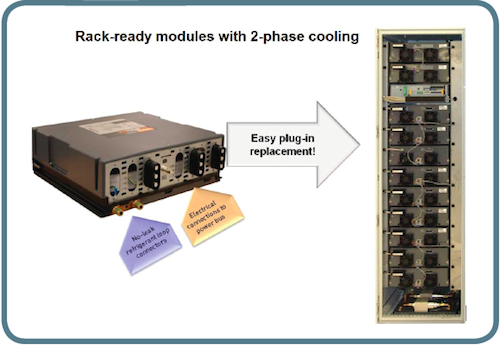
For small, compact equipment, Parker Hannafin’s Precision Cooling Systems developed the system in a rack-ready modular design to cool high-density power converters and inverters at capacities starting at 1.5 MW.
Almost maintenance free
Wind-turbine operators will appreciate that evaporative precision-cooling equipment requires no regular service. This is of particular importance with offshore wind farms, where accessibility for routine servicing is a major challenge and often results in costly downtime. In harsh winter conditions, entire wind farms may be inaccessible for days.
Two-phase precision cooling equipment is almost maintenance-free because:
• Pumps are more than twice as reliable as comparable water pumps.
• It is leak-proof. Should someone inadvert-ently damage the system causing a leak, the nonconductive coolant will flash to gas and not damage electronic components.
• The coolant neither freezes by nature nor requires additives or deionizers.
• The noncorrosive coolant does not react with metals.
• The only filter included in the system is a “dryer” to remove residual water or humidity from the system upon initial charge, which eliminates corrosion potential.
• It can be equipped with dry-break con-nectors for ease of module replacement, minimizing downtime during component failure replacement.
Building it in
The ease of integrating a new cooling system cannot be overemphasized. The rack-ready thermal system can be designed directly into custom cabinets or racks in nacelles, or provided in a drop-in configuration to retrofit legacy water or air cooling systems. The drop-in replacement consists of a stand-alone cooling unit, coupled with configurable plug-and-play cold-plate kits to build into various subsystems—an ideal design where a central cooling loop can support the generator, power conversion electronics, and reactor.
Rack-ready modules show how it’s possible to design high-density power converters and inverters at capacities starting at 1.5 MW. Modular inverter sections can be paralleled for high power installations. The system features electrical connectors to power bus and no-leak refrigerant connectors for an easy plug-in replacement. In addition, it scales up to 100 kW of heat rejection.
WPE
Filed Under: Components, Nacelle, Turbines

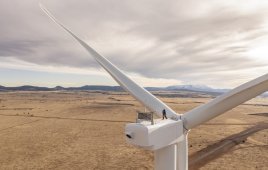

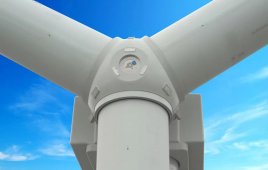
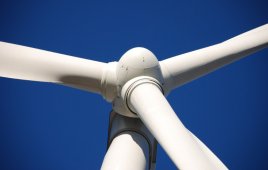
How much coolant (gallons) goes into each Nacelle cooling system? I recently had a product formulated and acquired the business of a Siemen’s production plant. I work with the largest supplier of glycol (antifreeze) in NA so are resources are vast and efficient.